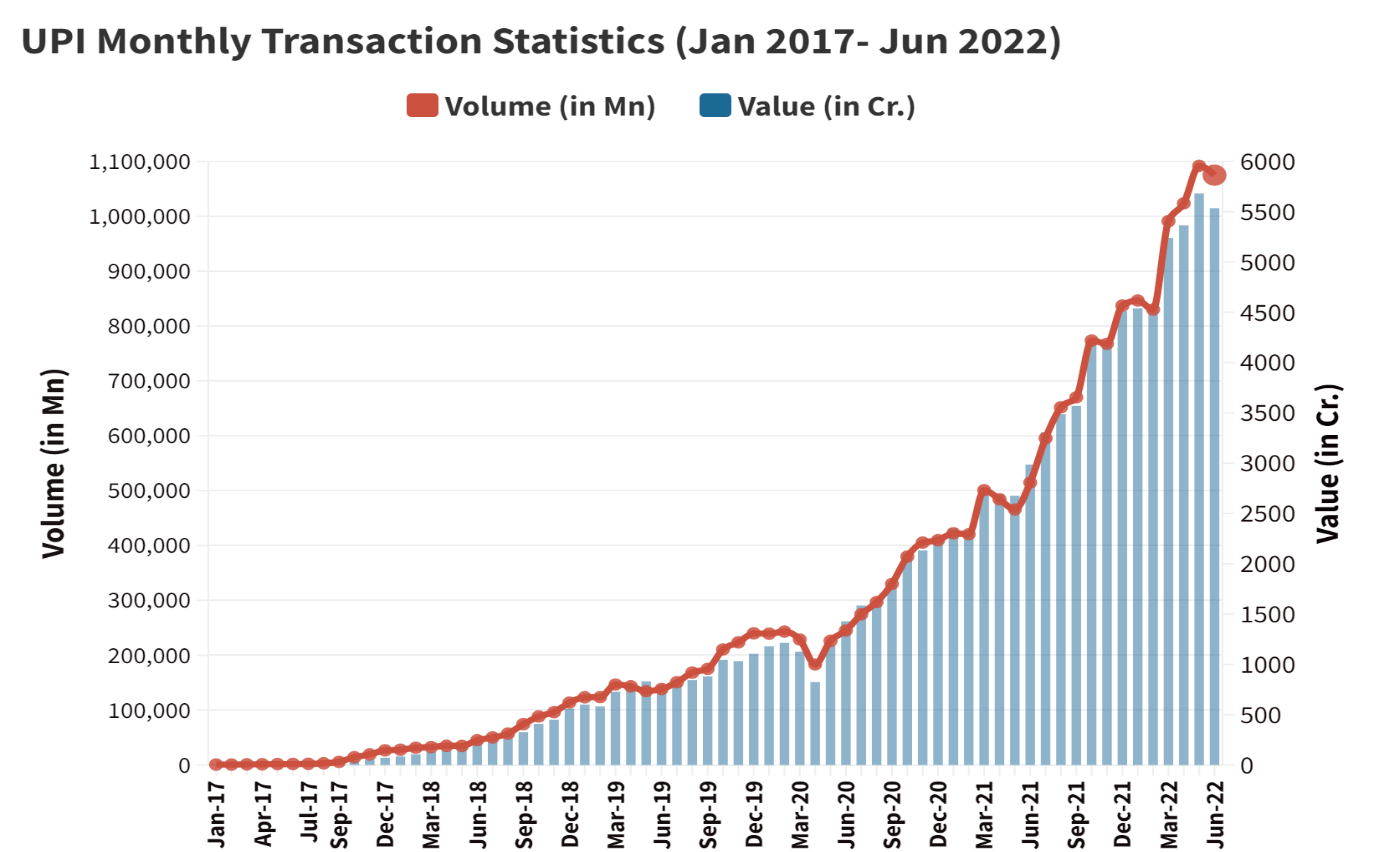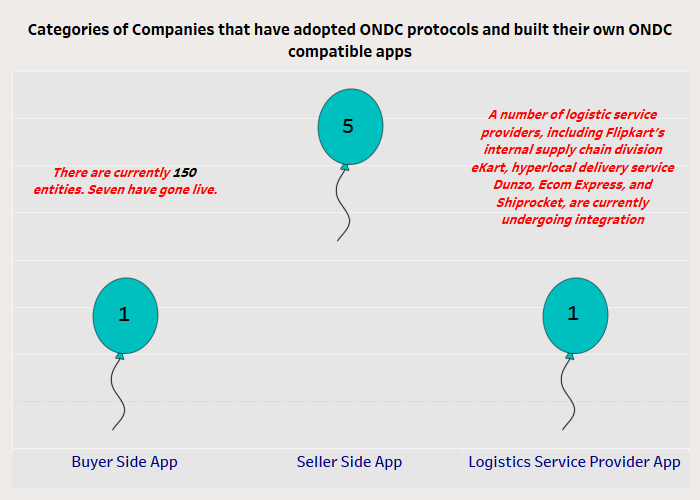ONDC: The next UPI?
We take a look at how UPI managed to integrate multiple platforms and created a network effect which has boosted innovation, ONDC has the same potential.

Why Open Network for Digital Commerce? A few key points before the story.
- Around 1.2 crore Kirana stores account for 80% of the retail sector in India.
- As of September 2020, India is estimated to have 4.25 crore Micro, Small and Medium Enterprises (MSMEs) that have the potential to flourish with innovative sales and marketing efforts but are not part of this digital revolution. Even on the consumer side, only a small portion (~20%) of the internet users in India are online shoppers.
- The Gross Merchandising Value (GMV) for the digital commerce retail market in India was ₹2.85 Lakh Crores (US$ 38 billion) in 2020, which is only 4.3% of the total retail GMV in India and well below the e-retail penetration in countries like China (25%), South Korea (26%), and UK (23%). By 2026, digital commerce in the retail sector in India is expected to grow to ₹15 Lakh Crores (US$ 200 billion)
- ONDC initiative will support the transformation of the ₹2.85 Lakh Crores (USD 38 Billion) Indian digital commerce market by revolutionising and democratising large-scale participation.
We take a look at how UPI managed to integrate multiple platforms and created a network effect which has boosted innovation, ONDC has the same potential.
The Government of India (GoI)’s Digital India program is an overarching initiative to get India ready for a knowledge-based transition into a digitally empowered society and a knowledge economy. The GOI aspires to make government services digitally accessible to residents and to assure the efficiency, transparency, and dependability of such services at reasonable rates. India is already home to rich ODEs like India Stack, UPI, and National Digital Health Mission to name a few.
To increase civic engagement, governments are utilizing open source software as a crucial component of the "digital agenda". The phrase "open source" was first used to describe free and open-source software (OSS). Code that is intended to be publicly accessible is known as open-source software; anybody can view, alter, and distribute the code as they see appropriate. By enabling a community of actors to check code for compliance with data privacy rules, aid in the discovery of flaws, and assure accountability, open source can help save costs, avoid the trap of vendor lock-ins, and also establish more trust within the ecosystem. Open source implies easier technical resolutions, and are relatively easily scalable.
ICT and digitalisation have bought significant development in the fields of finance, marketing, economic operation, etc. The paramountcy of digitalisation in banking and payment systems cannot be underestimated. In this new generation of smartphone technology, one of the most useful innovation technologies was the introduction of digital payment systems. With the help of UPI, India moved a step ahead toward a cashless economy and a revolution made in the Indian Banking System. It merges several banking services and features, seamless fund routing, and merchant payments under one umbrella.
The Covid-19 pandemic brought a massive shift to digital payments as physical transactions stopped and consumers were coerced to buy almost everything online, contactless ways to pay increased dramatically. This pandemic was a significant catalyst for the adoption of digital payments and digital forms of commerce. UPI, which was previously hailed as a platform that would only serve a few urban districts, has quickly emerged as "the" payment interface for India, used by both buyers and sellers, including both large and small retailers. The trust in UPI has played a huge part in this ecosystem.

There are more than 100 million active users of UPI every month in India. With the rise of e-commerce, in 2021, the number of digital buyers is at 2.14 billion.

Retail transactions are referred to as transactions having low-value denominations and high numbers. A variety of characteristics are exhibited by retail payment systems. They deal with numerous low-value individual payments in particular. To begin with, the term retail payment refers to a type of payment processing system that handles a significant number of low-value payments for the purchase and sale of goods & services.
They are used in a wider range of circumstances than interbank transactions, namely in-person payment using POS computers and payment over the internet. According to NPCI, UPI - Unified Payments Interface placed the first position in the retail payment system in the last five years. Maximum transactions done in FY 2022 implies 45,967 million transactions with an amount of 84,175.72 billion. Followed by IMPS (4,659 million and 41,686.46 billion), NACH- National Automated Clearing House (3,821million, 21,724.55 billion), and NFS - National Financial Switch (3,793million, 15,771.55billion) all figures in ₹ (INR).
Platforms that enabled online marketplaces for buyers and sellers have developed into big integrated systems that link the vendor and the buyer with integrated services like storage, logistics, payment processing, etc. The flexibility of the sellers is restricted by the terms and conditions that each platform has, which may limit the scope and diversity of participation. The digital commerce environment in India is not an exception to the aforementioned difficulties. The foundation of digital India was laid down in JAM stack but facilitating online payments and making credit easier to get to promote trade and entrepreneurship was the true test of India's economic digitalization.

Now, the GoI is enabling the establishment of an interoperable open network (Open Network for Digital Commerce - ONDC) to unlock the value trapped within the ecosystem. According to Piyush Goyal, Union Minister for Commerce and Industry, ONDC is another game-changing idea to democratize commerce, following UPI. It will bring together buyers, sellers, and logistics providers on one single platform. ONDC is a government-initiated, publicly accessible open gateway established to assist micro and small local businesses through e-commerce. The motivation for developing this Open Network for Digital Commerce protocol is to challenge the dominance of e-commerce titans such as Amazon and Flipkart in India. Though it is still in its early stages, it has the potential to significantly improve the efficacy of its functional operations through increased visibility, robust interoperability, and fair pricing
ONDC is a not for profit, open gateway that got integrated into the private sector on December 31, 2021. This open protocol holds the power to democratise the e-commerce industry in India. ONDC is UPI of e-commerce. What UPI is to e-payments, ONDC is to e-commerce. Transactions can be performed between buyers and sellers as long as they are connected on any app via the ONDC network. It's more like using Google Pay to scan a code within the Paytm app. One of the primary goals of ONDC is to give all local SMEs and retailers a fair chance to reclaim their business potential and profit. It aims at democratising the e-commerce space. It's more like using Google Pay to scan a code within the Paytm app.
The ministry on 29th April, 2022 began a UPI-like protocol, the open network for digital commerce (ONDC), in five cities as part of its pilot program. ONDC's chief executive officer, T Koshy, stated that there are currently 150 entities. Seven of these have gone live, ten more will go live in the coming months, and 70 entities will be integrated by the end of this year. The pilot for the section 8 firm has been extended to Lucknow, as the sixth city. Currently, seven entities three on the buyer side, four sellers, and three logistic providers are operational, while another ten are in advanced phases of integration. On the buyer's side, Paytm has already joined the network, and a sizable private bank is expected to launch in a month. A number of logistic service providers, including eKart, Dunzo, Ecom Express, and Shiprocket, are currently undergoing integration. On the logistical side, Bengaluru-based Loadshare is already active on the network, said T Koshy. He also said that analytics company Sellerapp, growth marketing firm Growth Falcon, local commerce platform eSamudaay, and retail software company GoFrugal have also joined the platform.


The additional secretary of DPIIT, Anil Agarwal, said that from the pilot phase of ONDC, they could observe and learn how it will impact the real-life environment. Once they know how it is going, they will make a final draft of the operations to use them as a set of standards. The ONDC is being established as a first-of-its-kind initiative globally to pave the way for reimagining digital commerce in India. A budget of Rs 150-200 crore was created for the first couple of years. Out of 20 chosen institutions, 17 have already contributed their share of Rs 10 crore each, the remaining three are expected to complete their contribution by the end of this year.
The ONDC can prove to be the holy grail of e-commerce, which can change the landscape of how the internet is being used for buying and selling as ONDC promotes interoperability to create an open and inclusive marketplace with minimum digital infrastructure. Sellers may reach more customers and improve their discoverability at a much lower price. As commissions will be out of the question, the income margins of the sellers will increase. ONDC will enable the buyers to choose from different sellers and have far-reaching access to local vendors and better pricing.







